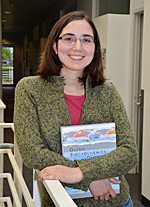You are here
Post-Doctoral Researcher to Advance Biogeochemical Modeling
02/15/12 Portland, Ore.
CMOP’s biogeochemical observation network in the Columbia River estuary is one of the most advanced in the world. Understanding the estuary’s biogeochemical pathways and ecological processes requires equally advanced modeling approaches.
 Clara Llebot, Post-doctoral Research ModelerTo help develop those models, CMOP has recently appointed Clara Llebot to the position of post-doctoral researcher for modeling. She joins the center’s multi-institutional modeling team to design a biogeochemical model of the Columbia River estuary.
Clara Llebot, Post-doctoral Research ModelerTo help develop those models, CMOP has recently appointed Clara Llebot to the position of post-doctoral researcher for modeling. She joins the center’s multi-institutional modeling team to design a biogeochemical model of the Columbia River estuary.
“We can't do everything at once, so my first project will consist of trying to simulate the Myrionecta rubra blooms in the estuary,” Llebot says. “This means we will have to integrate the knowledge that CMOP has been accumulating about the behavior and physiology of this ciliate and its relationship with the other actors in the estuary such as other plankton species, or the amount of oxygen or nutrients.”
The biogeochemical observation network supplies a wealth of information about the processes happening in the estuary. This data will assist Llebot in validating the biogeochemical model and ensuring it is accurate. In turn, the model will provide results at a much higher resolution than an observation network could ever measure and will allow scientists to design experiments and test hypotheses that would be difficult or impossible to carry on as field studies.
Llebot’s background is in environmental sciences. She received her Ph.D. in oceanography at the Institute of Marine Sciences of Barcelona. Her dissertation addressed the interactions between water circulation dynamics, nutrient availability and the structure of the phytoplanktonic community in two estuarine bays in the Northwest Mediterranean.
As part of her thesis, she designed a zero-dimensional ecosystem model with two groups of phytoplankton, zooplankton, and organic and inorganic nutrients to evaluate the nutrient fluxes in the bay.
After graduating in 2011, Llebot worked as a postdoctoral fellow with the College of Oceanic and Atmospheric Sciences at Oregon State University, advised by Yvette Spitz. There she gained valuable knowledge and experience using models to gain insight about harmful algal blooms on the Oregon Coast.
“Numerical modeling will in the next few years play a key role in advancing and integrating our science,” says António Baptista, director of CMOP. “Clara will be at the core of the development of the ‘estuarine bioreactor’ model, our most ambitious attempt at capturing the combined roles of the dominant biological hotspots in the estuary.”
Llebot will work under the joint supervision of Baptista and Spitz, and will commute between the Oregon Health & Science University’s West Campus, in Beaverton, Oregon, and OSU’s campus in Corvallis.
Written by Jeff Schilling






